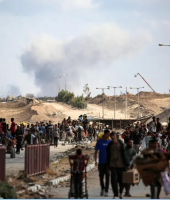- World
- Afghanistan's modest economic growth threatened by rising poverty, population, security threats, ina...
Afghanistan's modest economic growth threatened by rising poverty, population, security threats, inadequate infrastructure, displacement: World Bank
On

Kabul, 8th October 2025
Afghanistan's economy has grown modestly in the past four years and continues to rise, though increasing poverty, lack of infrastructure, weak governance, persistent displacement, and persistent security threats continue to hamper this trend, reported the World Bank.
It further warned that these factors could overshadow the few strides the war-ravaged country has made in recent years.
It further warned that these factors could overshadow the few strides the war-ravaged country has made in recent years.
According to Khamma News, these findings were published as part of the World Bank's latest Economic update on West Asia, North Africa, Afghanistan and Pakistan, titled 'Jobs and Women: Untapped Talent, Unrealised Growth'.
Kabul's GDP is projected to grow by about 4.3 percent in fiscal years 2025–2026, driven largely by household and public consumption. However, this rise, expected to be around 8.6 percent, per capita income, is insufficient to keep pace with its increasing population, and is thus projected to decline by nearly 4 percent, keeping millions of Afghans in extreme poverty.
The World Bank estimates that between 15.2 and 23.8 million Afghans — almost half the population — live on less than USD 3 a day, one of the highest poverty rates in the region.
This was attributed to a myriad of overlapping crises, including forced deportation of refugees, natural disasters, inadequate infrastructure, and weak governance, compounded further by international isolation.
Since September 2023, more than 4 million Afghans have returned from Pakistan and Iran, with 2.1 million repatriated between January and July 2025, most of whom were noted to be involuntary and forced.
The report noted that the Aug 2025 earthquake in eastern Afghanistan, which killed more than 2,000 people, worsened its already potent economic distress, as the damages were estimated to account for over USD 183 million, roughly 1 percent of GDP, destroying homes, livestock, and vital rural infrastructure.
The earthquake underscored the country's limited ability to respond to crises amid declining international aid, lack of personnel, and weak infrastructure.
Regionally, the World Bank forecasts modest economic growth of 2.8 percent in 2025 and 3.3 percent in 2026 for the broader regions of West Asia, North Africa, Afghanistan, and the Pakistan region.
However, Afghanistan's recovery remains highly unstable and uncertain due to waves of sanctions, security challenges, and isolation. The sharp reduction in aid, as cautioned by the body, has already led to the closure of hundreds of health centres, depriving millions of essential services.
000
About The Author

Latest News
08 Oct 2025 22:03:58
Kabul, 8th October 2025
Afghanistan's economy has grown modestly in the past four years and continues to rise, though increasing...


_(cropped).jpg)







